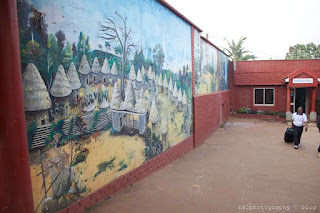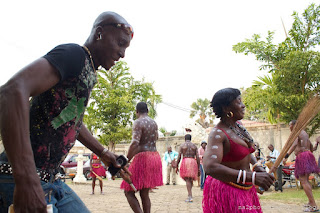Day 4 - And Now We Meet
Day 4 was a day full of historical events as well as laughs and fun.
Chief Nembot was absolutely marvelous to us. He gave us a beautiful handmade picture and one of his queens gave us a map of all the Bamileke kingdoms in the area. It was the second time that we had received something from a Chief that was not affiliated to dining. The Chief of the Baleng has about 28 wives and 300 children.
Chief Nembot gave us the privilege of touring his apartment as well as the kingdom's new technology center with computers and internet available.
Once we left the Baleng kingdom, we headed over to have lunch with another Bamileke chief, Chief Djomo Kamga of the Bandjoun. Chief Djomo is described as a visionary, like his grandfather who reigned before him, has over 20 wives and an unknown number of children. The Bandjoun are currently in the process of building a craft center to display their art as well as house a program where artists in the kingdom continue the practice of passing down their trades to younger generations. The kingdom also features a museum for the Bandjoun.
The next stop was one that will forever be in our collective memory. To say that the Tikar chiefs outdid themselves and everyone else is an understatement. As we entered their compound, we were in shock and awe at how beautiful and elaborate it was. We were again given special instructions on how to greet the chiefs: bow before them and instead of shaking hands, they would touch our right shoulder.
There were a number of handcarved statues and artifacts. The head Chief took us around, showed us every single one of them, and gave us history about them. Following that, we had a out of this world lunch where we were served Moet Chandon at the tail end. Add in the dancing and music, the formal naming ceremony for all of the Tikar in our group, the smiling faces and the laughs and this portion of the trip, by far, has been the most exciting and memorable (not to outdo the trip to Bimbia).
Day 5 is by far, our most formal day. It will include a press conference on slave trade along with a reception at the US Embassay in Yaounde (the capital of Cameroon) and a New Years Eve Party.
Jean "posing" for the camera LOL
Randy Joe Sa'ah, a reporter for BBC News Africa, Brenda, Regina, Nicka, and Sopheia
We began the day with a brief stop where we met with the Chief Nembot Thomas of the Baleng, which is part of the Bamileke tribe. I sat with intense anticipation just to see the Chief's face, wondering if he looked like any of our ancestors. When he appeared, all I could see was the face of Rev. Francis Joseph Atlas, Sr. I pulled out a picture of Louis Balfour/Bareford Atlas, Sr. (Rev. Atlas' father) and held it up to a picture of Chief Nembot's father. The resemblance was striking.
Chief Nembot Thomas of the Baleng (Bamileke)
Chief Nembot gave us the privilege of touring his apartment as well as the kingdom's new technology center with computers and internet available.
Sopheia with one of the 28 Queens of the Baleng.
Houses of the 28 wives
Nicka in Chief Nembot's apartment
On the way to the tech center, I was able to catch some tribe members, one who was a little girl who reminded me so much of myself when I was her age.
The houses of the Baleng chief's 28 wives (another angle)
The Baleng Technology Center
Chief Djomo's compound
Chief Djomo Kamga
Ralston, our principal photographer
Our interesting bus driver
This is one of the earlier chiefs who I dubbed, Chief Ice Cube LOL. He's an ancestor of Chief Djomo.
The massive building to the right is one where tribal rituals are held. As you can see, the size of it is incredible and the roof is made from raffia.
There were a number of handcarved statues and artifacts. The head Chief took us around, showed us every single one of them, and gave us history about them. Following that, we had a out of this world lunch where we were served Moet Chandon at the tail end. Add in the dancing and music, the formal naming ceremony for all of the Tikar in our group, the smiling faces and the laughs and this portion of the trip, by far, has been the most exciting and memorable (not to outdo the trip to Bimbia).
The man playing this flute did so with his nose. It was amazing to watch.
The youngest member of our delegation.









































































Comments